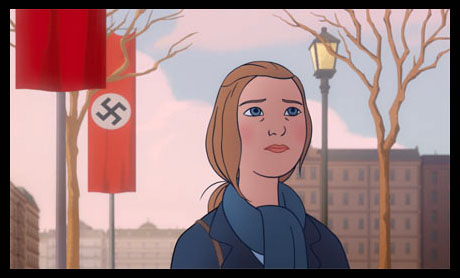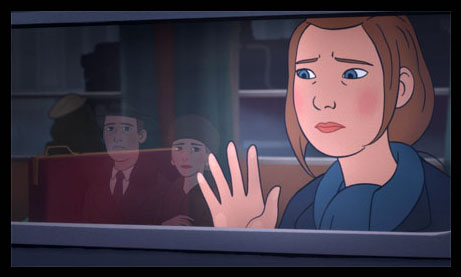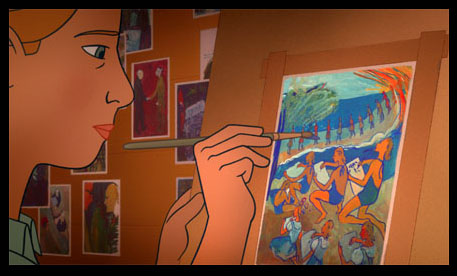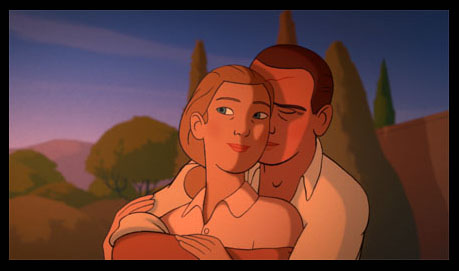
This is my in-depth conversation with Tahir Rana and Eric Warin, the directors of new animated feature Charlotte. This drama, based on the life of artist Charlotte Salomon, opens in select theaters on Friday April 22nd and will expand to more cinemas over the coming weeks. Charlotte chronicles the life of Salomon (voiced in the English-language version by Keira Knightley), a young German-Jewish artist who lived in Berlin and France at the height of WWII. Her collection of paintings, “Life? Or Theatre?” is considered one of the most astounding artistic achievements of all-time.
Jackson Murphy: The film is excellent. I want to start with the fact that animation is art. Tahir, as you were making this [movie], what was it about Charlotte’s story that made you appreciate art, drawing, illustrating and animation even more?
Tahir Rana: That question is such a topical one, I think… especially how it relates to using animation in telling stories like this. Charlotte Salomon’s story has been, over the years, has been adapted as a stage play. There’s been a live-action film and several other adaptations. But it’s never been tackled in animation. And when you think about it, Charlotte herself being an expressionist artist — and a really great one — it really feels like a natural medium to use. There’s a great opportunity to utilize all the tools that are in an animator’s toolkit. You can use color, motion and movement to portray and convey what Charlotte was also doing in her own paintings.

Tahir Rana: It was a pretty easy decision to make. The only question was: How do we leverage Charlotte’s own artwork and put her own artwork into the film? We made some decisions about where to pay homage to Charlotte’s work. Charlotte never used the color black in her paintings, so we never used black in our film. There were a number of compositions: a scene with Charlotte on the bed with her head in her hands was lifted from a painting she did. What was the most effective was our transition device: we used Charlotte’s paintings and they came to life and transported us from one place to another. It was a great opportunity to show the audience: this is the artist; this is her work and really make it a central part of the film.

Tahir Rana
JM: I completely agree. Eric, you have these serious themes about the demons in our lives that can impact us, loss and suicide. Some of it hit very close to home for me. There’s an opportunity here that you guys are taking advantage of: to explore more serious, adult themes with the animation you present.
Eric Warin: Yeah. What is very difficult is if we all agree animation is not just for kids, it’s a very expensive way of doing movies. There is another layer about that. First of all, you have to convince people that we wanna go with animation for this movie. Lots of financial guys say, “What about doing it live [action]?” To be honest, I had the exact same issues when I did “Leap!” They’re saying, “That’s about a young girl who wants to be a ballerina. Why not do it live?” Of course, for such a movie when you try to target adult audiences and with such deep and emotional levels, you have to convince very much and also… it’s very expensive. You have to make lots of choices and you don’t have [a huge] budget. The budget you have depends on the kind of target you’re going to hit.
Doing movies is trying to take the audience and drive them into the characters and the thematic you want them to go through. It’s a heavy story. She had lots of things: personal issues, family issues… and above all… it’s just about a girl who wants to be listened [to]. She wants to make some decisions and right now everybody’s making decisions for her. That’s something that any teenager can relate to. That’s very universal. This is a young girl and a painter who has lots of things in her family. And then the war starts. You can’t predict it and things are going wild and crazy. Through that you see how to make your path and live your life. That’s what “Charlotte” is… and it’s interesting to see how we can take that from the shadows and show it to the world. She hasn’t been forgotten. Both Tahir and I were in fine arts school but we never knew about her. Now we’re taking where she stopped and [move] forward and make it work and be visible.

JM: You succeed with that. She was 26 years old and it’s amazing that she lived her life to the fullest in that period of time — and she almost predicted that her life wasn’t going to go much farther. When you realize and discover that, that’s powerful. I love the transitions you do. Tahir, can you talk about the visual relationship between the look of the characters and the backgrounds? As I was watching it and connecting to these characters, there’s this friendliness to the characters we want to like and when you look at the backgrounds… there’s this distinct to it.
TR: It’s good that you point that out. In terms of the aesthetic we were going for, the film is divided into two parts. The darkness that you describe really consumes most of the film that takes place in Berlin with the onset of the racial intolerance. Berlin becomes very hostile and cold. When Charlotte goes to the south of France, all of a sudden you see that the palette has completely changed. Now it’s bright and sunny. This is the period of Charlotte’s life where she’s really most prolific artistically. We wanted to showcase that inspiration she draws from her environment. That’s really apparent in her work. It was a decision we made purposefully to give the audience an idea of how and why and under the conditions that Charlotte drew her… her inspiration. Her love was also with her.
The actual character design went through a lot of development. We did experiment with a style that was very similar to the way Charlotte depicted her characters in “Life? or Theatre?” Ultimately her style of exaggeration took us out of the story that we were telling a little bit too much. It was more in the fantasy realm. So we ended up grounding her in realism: correct anatomy, five fingers. Using the backgrounds the way we did we were still able to convey the emotional response we wanted from the audience.

EW: We really wanted the lights to come in and be at the midpoint of the story. Suddenly light is very important in her life. She’s blooming. When she arrives to France, she suddenly wakes up. She grows up and suddenly can now start to decide for herself. We understand the family weight better. It’s really very interesting to see how she’s starting to make her own decisions and attack the beast inside.
JM: I can tell through Keira Knightley’s voice performance not only how delicate her dialogue deliveries are but how Charlotte changes over the course of the movie and her confidence level increasing. Eric, could you tell that in how Keira Knightley was delivering her lines?

Eric Warin
JM: Wow. You chose the right takes! Tahir, how does this powerful line resonate with you?: “It doesn’t matter if life loves us. We must love life.”
TR: It’s a really important line in the film. It comes to the forefront with Charlotte and her own arc that she goes through. Charlotte as a younger, naive girl, that line was given to her and she ate it up with wide eyes. She kind of adopts it as a bit of a life philosophy. Without really understanding it and going through life, she later repeats the line to another love interest who’s more genuine, and that’s when she realizes that it works better both ways: if you loved life and life loved you. It’s really interesting when Charlotte gets that moment to think, “I was kind of spoonfed this line by this casanova.” It’s a really important moment for Charlotte when she’s able to let go of what she’s held onto… and embrace the man she eventually marries. It’s good that you picked up on that. That was something we purposefully highlighted as a device to show Charlotte’s development.
JM: Eric, if you were to paint many highlights of your life — just as Charlotte did — and you were to make a painting of this experience making this movie, what would you want that painting to look like?
EW: (laughs) Oh my gosh! I did not expect that question. That’s a very good question. (laughs) Wow. Any movie is a fight against yourself, against time… people. It’s some very intensive moments. It’s giving birth to something. It’s as pleasant and joyful as it is hard. That’s life. It’s a mix of lots of emotions. Whatever happens in life: what matters is what you do instead of just waiting for or just receiving. It’s what you do to make it matter. She decided suddenly to listen to what she had to do. A movie is like a river: you have to go faster than the river if you want to be able to direct your boat and actually make something. Maybe a boat in Niagara Falls could be a funny image.

JM: (laughs) Tahir, I’ll give you the same question. Would your painting look similar?
TR: If it was a boat it would definitely be capsized and we’d all be trying to get back. Such a great question: what does the collage of your life look like? It would be great if there were a lot of different colors and experiences — something representative of all the places you’ve been and the people you’ve seen. I thumbed through Charlotte’s work. It’s phenomenal. It’s really extraordinary the way she was able to depict her life knowing that she was soon gonna be plucked from the earth. Her brushstrokes are very hurried [and] very fast. She wanted to really share her legacy with the world — and her family’s story. Mission accomplished. We can only dream that we are also able to create something so eternal and everlasting. Maybe I’ll get started on that mural.
It’s so cheesy… I don’t even know what it was advertising… [It’s Expedia] …but he’s walking towards the camera and he says, “By the time you’re gone, do you think you’re gonna regret the things you didn’t buy or the places that you didn’t see?” For a cheesy commercial, it’s so remarkable. That is true. You really wanna experience things and live things. Those aren’t material possessions. It would definitely be the places I’ve gone to and the things I’ve experienced and not just whatever car is in my driveway.
- INTERVIEW: “Inside Out 2” Director And Producer On Pixar Sequel - April 16, 2024
- INTERVIEW: “Puffin Rock And The New Friends” And 25 Years Of Cartoon Saloon - April 10, 2024
- INTERVIEW: “Chicken For Linda!” Directors On Annecy Winning Feature - April 9, 2024


 April 19th, 2022
April 19th, 2022  Jackson Murphy
Jackson Murphy  Posted in
Posted in  Tags:
Tags: 






